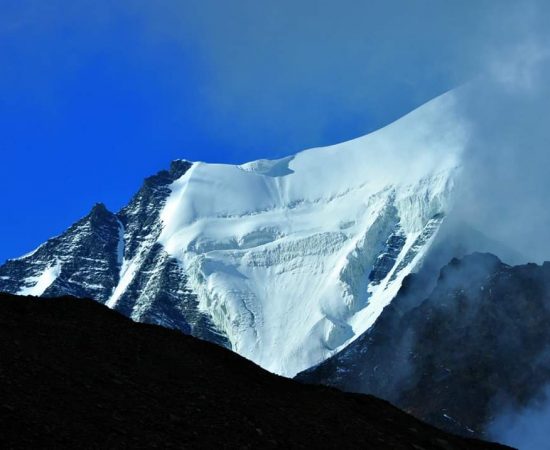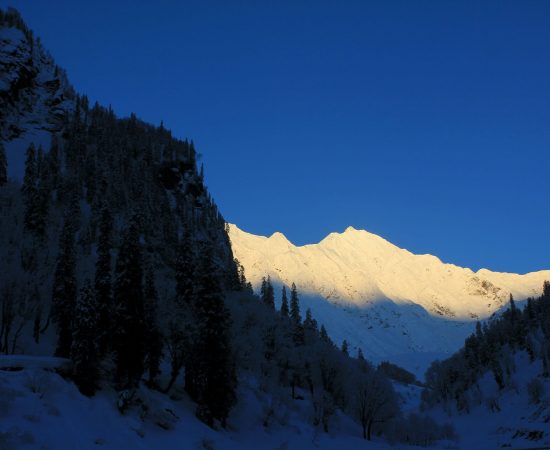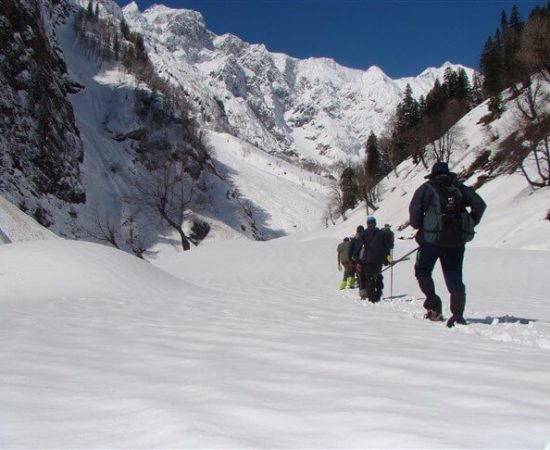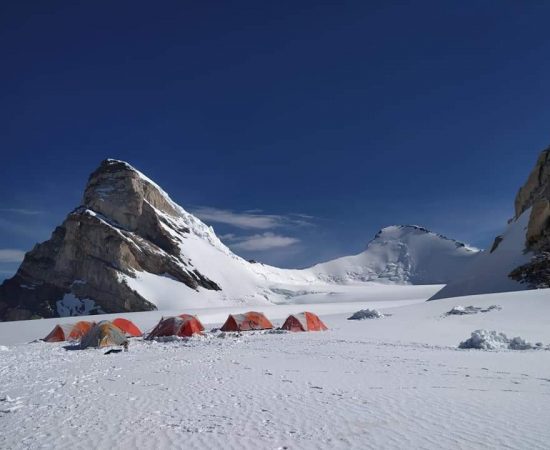Jagatsukh Peak Expedition
Manali, Himachal Pradesh
Rated 4.9/5.0 on TripAdvisor. 550 Reviews

572 Reviews (5.0)
5/5

572 Reviews (5.0)
5/5
Key Highlights
- Altitude : 5050mts
- Time : 8 Days – 7 Nights
- Region: Manali
- Best Time: June-October
- Distance: 34Kms
- Grade: Easy
Overview
Jagatsukh Peak Expedition
Located in the Kullu Valley in Himachal Pradesh, in the Pir Panjal Range of Himalayas, at a height of 5,050M, Jagatsukh Peak is an ideal transition point for trekkers interested in taking up climbing. The ascent to the summit of this hill, which passes via the picturesque town of Jagatsukh, is a great first mountaineering experience since it challenges you to reach new heights without requiring advanced technical skills.
The landscape on approach to the mountain’s base camp is breathtaking, consisting mostly of vast meadows with a profusion of brilliant wildflowers, a breathtaking panorama of the whole mountain range, and a spectacular performance put on by the clouds. When the trees and shrubs finally give out, you’ll find yourself in a barren scene of rocks, moraine, and the first flakes of snow that will soon blanket the whole mountain.
Thrilling panoramas of Deo Tibba, Indrasan, Mt. Norbulinga, and other notorious peaks in the surrounding ranges may be seen from the top. It’s a great trip for first-timers, but you’ll need to be physically strong and have expertise walking at high altitude if you want to survive in the Himalayas.
The months of May and June, just before the monsoons, are ideal for making the ascent of Jagatsukh Peak, followed closely by the months of September and October, right after the monsoons have passed.
Cost Per Person
₹ 50,000
₹ 40,500
Key Highlights
- Altitude : 5050 mtr
- Time : 8 Days – 7 Nights
- Region: Manali
- Best Time: June-October
- Grade: Easy
Complete
Itinerary of Expedition
Manali, the trail’s starting point, is a major tourist hub and relatively easy starting point for the journey. This article (How to Reach Manali: All You Need to Know) may be useful if you need advice on how to get to this high-altitude backpacking hub. The first day is set out for everyone to arrive in Manali and check into their respective hotels. The first portion of the day is for acclimatising to the altitude and to one another. While our bodies adjust to the altitude, we meet as a group to discuss the next events: our itinerary, what to anticipate, and some of the most fundamental rules for being respectful of the mountains and its sacred nature. Since we are a teaching organisation, we spend some time on day one going over some basic tips for packing your bags for the climb. After setting up the necessary hardware, a demonstration of the same is performed. This day is rather straightforward, but it is crucially important for the events that will follow!
Day2: From Manali (2,050M) to Jagatsukh (1,950M) to Chikka (3,175M)
After finishing our morning meal, we’ll get in the car and proceed to the trailhead in Jagatsukh. We can walk to this nearby village from Manali in about an hour. The trip to the Chikka meadows, which we expect to take around three hours, begins here. It’s a light day, ideal for adjusting to the altitude you arrived at only the day before. The walk down the path is not only beautiful, but also incredibly invigorating. There is a gentle ascent through a pine forest along a small valley. Campsite lies in Chikka’s wide pastoral terrain, next to the raucous Jagatsukh Nala.
Day3: From Chikka to Seri Base Camp (3,700M)
Today, we are leaving after a quick breakfast, and will hopefully be on our way by 9 AM. We’re not too far away, just next to the Jagatsukh Nala. The first hour of the day’s hike is a steady climb through dense woodland. After an hour, the trees thin out and give way to birch trees, then shrubs, and ultimately high altitude meadows. The brightest wildflowers you’ve ever seen await you in the meadows where you’ll be warmly greeted. The rise from 3,175M to 3,700M is very easygoing, with just a few spots of old snow remaining as remnants of winter and a few spots of stones along the way. Difficulty increases, but so do the rewarding vistas along the way. We continue our journey down the Nala, passing a freshwater spring at Panduropa and Dudu Patthar on our way to the open grasslands of Seri, with the towering Tainta cliffs to our left and the cascading waterfalls on the rocks below. To get to our day’s campground, we have to ford the zigzagging river. For the night, we set up camp on the flatlands, just across from a tremendous waterfall. In addition to being our home for the duration of the adventure, this picturesque campground serves as our base. At dusk, we set out for a stroll to help us adjust to the altitude. Overnight stay in tents at Base Camp.
Day 4 and 5: From Seri Base Camp to Summit Camp
Making many passes at a given location is a common tactic used by expeditions in the name of acclimatisation. What this implies is that we will be moving on to the next campground and then descending for the night. Climbing’s cardinal rule is “climb high, sleep low,” so the following day we go up again to claim the next campsite. On Day 4, we divide our equipment and ration amongst one another and start transporting supplies by load ferry from Base Camp to Summit Camp, with the intention of moving in on Day 5.
The expedition has reached its day of climax and we will begin their summit attempt in the dead of night, when the snow is at its steadiest. The ascent requires a significant amount of elevation gain. Starting from the summit camp, climb to the peak, and then make your way back down to the base camp in a single, lengthy day. The ascent requires travelling through moraine fields, which ultimately give way to glaciers. Both the ascent and the top provide breathtaking views of the surrounding mountains. Before descending to Manali tomorrow, we will spend the night at base camp.
Day7: From Basecamp (3,700M) to Manali (2,050M)
On day seven, we begin our descent from Seri, our base camp, and hike to Chikka, where we will get a ride back to Manali. Plan to arrive in the area by the early evening. Due to the unpredictability of the Himalayan climate, we advise booking your return trip with a day or two of leeway.
Day8: Extra day or reserve day
A backup summit attempt is planned on Day 8 in case of inclement weather or other obstacles. Only in the event that anything really unforeseen and unavoidable occurs at the last minute to prevent the first summit push would this be employed.
Enquiry For Group Bookings
Guidelines
➽ Preparation for Expedition
As you well know, the great Himalayan expedition is one that requires careful preparation, a strategy that allows for enough flexibility to adapt to whatever challenges may arise.
Therefore, here are some things to consider before setting out on your Jagatsukh Peak Expedition:
⦿ Physically – You should start working out at least a month before signing up for a program if you want to be physically prepared for the rigours of a journey. Strengthen your legs by jogging and working out regularly to increase your stamina. To better acclimatise to the environment and increase your resilience on the walk, you should give up smoking and undertake breathing exercises twice a day. Engage in vigorous physical activity, such as playing sports, doing Yoga, or running.
⦿ Mentally –
Getting in shape physically is essential, but mental preparation is just as crucial for a successful walk. Take time to enjoy your regular activities, maintain a healthy diet and sleep schedule, and unwind before embarking on a hike. Predictions regarding the journey should not cause mental worry. Spend time with your closest pals to recharge your batteries and renew your spirit. Pre-trek preconceptions are unwarranted since the first contact with the other trekkers is certain to be a source of inspiration and energy. Conditions during the walk will contribute to the increase in mental readiness. The mental repercussions of physical disadvantages will not be ignored. So, when you hike, pay attention to different regions of your body and purposefully relax them. If you want to enjoy your hike, you should learn to loosen up a little, particularly in the hips. Think about your descent as a simple dance, and enjoy the natural rhythms that the path and your body can discover together gradually, whether you’re on a flowing downhill route or a frightening slope. Try out a few new walking techniques to add some fun to your commute without worrying about getting somewhere in particular. Maintaining mental fitness mostly requires a willingness to relax and take in the journey, rather than subjecting oneself to undue stress.
Guidelines
➽ Things to Carry
- Good Trekking Boots: You need sturdy trekking boots with supportive high ankles. Don’t bring your running shoes. U can carry extra floaters/flip flops also.
- Wear warm clothing, such three-layer coats, fleece upper, hollow fill or down-filled jackets. Carry full-sleeved T-shirt. Carry cotton hiking trek pants and warm pant for your lower body. Never bring shorts or jeans on a hike.
- Take top and bottom thermals with you.
- Quick dry towel with light weight and Personal toiletries. Suns cream lotion, sanitizer, tooth brush ad toothpaste, lip balm and antibacterial powder.
- Socks: Bring two pairs of regular socks and two pair of wool socks for wearing at night.
- A head torch is required.
- Sunglasses/ Goggle: UV-protected sunglasses are necessary to protect against sunlight and Snow Mountain.
- There should also be a woolen cap / balaclava, cap, neck gaiter cum face mask and warm fleece and waterproof summit gloves since it will be chilly. Keep waterproof gloves on hand since they become wet in the snow.
- Everyone taking part in the activity should have their own lunchbox, spoon, mug and water bottle/ hydration pack of 2 ltr.
- Raincoats/ponchos: Since snowfall and rain are frequent at high elevations, it is important to have one on hand so as to avoid getting wet.
- Trekking bag of 75 ltr with rain cover.
- Walking stick.
- Personal first aid box. Emergency ration, energy bars, dry fruit, electoral/Ors
- Personal technical gears list of mountaineering (on rent basis available)
- Climbing boot, Crampon, Sleeping bag (optional), Ice axe, seat harness, Rope and tape sling, helmet, Summit gloves, Gaiters, Carabineers 2 no (screw), figure of eight/descendor, Zumar (Ascendor),
- Required Documents:
a) Registration Form
b) Medical Certificate (signed by a licensed MBBS physician)
c) NOC form (completed by the trekker)
d) 2 passport-size photos
e) ID Proof photo (not PAN)
f) Basic Mountaineering Course certificate.
g) Insurance upto 5 lac..
Guidelines
➽ How to Reach
How to reach Manali:
Delhi and Manali are linked nicely. You may travel from Delhi to Manali in 12 to 14 hours via overnight bus (approx 540 KMS). Online ticket reservations are available at www.redbus.in and www.hrtc.gov.in Tip: Given the distance between Delhi and Manali, the majority of Volvo private buses depart Delhi between 5 and 8 p.m. At 8.30 p.m., the final government bus departs from ISBT Kashmere Gate. Between Rs. 1,200 and Rs. 1,800 are charged by Volvo buses each sector from Delhi to Manali and vice versa. Delhi to Manali: Buses depart from Manali for Delhi between 4 and 8 p.m., same like the return trip. You should expect to arrive in Delhi any time between six and ten in the morning. Plan your subsequent trips just after midday, leaving ample time for bus delays.
How to reach Naggar:
Naggar is 18 kilometres from Manali, and there are several buses that operate every 15 minutes. Alternatively, one may get out at Patlikuhal, which is 5 kilometres from Naggar on the right bank highway. Between Kullu and Manali is Patlikuhal. To get to Naggar, you may take a cab or a local bus from Manali or Patlikuhal.
The closest train station is:
Ambala (350 miles) and Chandigarh are the closest railway stations (310 kms). Advice: From Chandigarh to Manali, regular buses and Volvos run in the evening. Volvo buses from Chandigarh to Manali and vice versa charge between Rs. 800 and Rs. 1,200 every sector.
The closest airport:
The closest airport to Manali is Bhuntar, which is 52 kilometres distant. From Bhuntar to Manali, taxi services are available and cost between Rs. 1500 and Rs. 2,500. Air travel between Bhuntar and Delhi is convenient. Airlines providing flights from Delhi and Chandigarh to Kullu include Indian Airlines, Kingfisher Airlines, MDLR Airlines, and Jagson Airlines.
➽ Trip Cost Includes
- Mountaineering (Instructor/guide) services provided by a highly trained, professional, and qualified Himalayan Adventure Trips staff.
- Certified local guide with extensive familiarity of the area.
- Climbing provides only vegetarian food (breakfast, lunch, and dinner).
- Staff include chefs, cooks, and helpers.
- High Altitude Force, Low Altitude Force, Porters, Mules for Common Equipment (Rations, Tents, Utensils, Central Climbing Equipment, etc.)
- Tents (to be shared), sleeping bags, air mattresses, and air pads are included. Inner
- We offer twin-share accommodations in dome, alpine, and high-altitude tents on all of our treks and expeditions. All necessary camping equipment, including air mattresses, a shelter for cooking and eating, a table and chairs, a stool, and more, would be supplied.
- Someone who can carry heavy items, set up high camps, repair ropes, etc. at high altitudes.
- Assistance from Guide All the Way to the Top
- High-altitude butane gas cooker
- The only meal offered at the hotel will be breakfast. All meals while on the walk will be supplied for you. Indian, Chinese, and Continental cuisines, all freshly cooked, will be on the menu.
- Tin-packaged food is what we’ll eat at high altitude.
- A standard first aid kit with oxygen masks for the patient.
- Camping fees, wildlife fees, and forest permits.
- Taxes imposed by the state.
➽ Trip cost Excludes
- Climbers may hire individual porters to carry their gear.
- Airport transportation costs
- Expenses for carrying still/video cameras etc.
- Irregular/Personal costs, such as laundry, phone calls, and gratuities.
- Climbing equipment such as ropes, pitons, snow bars, crabs, etc.
- Your own personal mountaineering equipment and clothes, as well as any specialised foods you may need
- Inner Line Permit.
- Health coverage or the price of a rescue mission
- Expenditures of a more personal character (such as booze, soda, bottled water, mineral water, canned or bottled drinks, candy, canned or packaged dried fruits, etc.)
- Provisions/food to or from the starting point of the trek.
- Any expenses that are incurred as a result of natural disasters, human error, or other unforeseeable occurrences.
- Protect your trip with a travel insurance policy.
- Authorization, licensing, and enlistment with the IMF.
- Payment for Liaison Officer (included for foreign expedition only)
- GST of 5%.
Guidelines
➽ Special Casual Leaves
Government employee can avail the benefit of special casual leave when u join us for a trekking expedition. As per the rule of the pay commission, special casual leave can be availed for up to 30 days in a calendar years for trekking and mountaineering expeditions through a register organization. Himalayan adventure trips are a register adventure tour operator register with Indian mountaineering foundation and Himachal Pradesh tourism. Candidates have to apply for leave at least 30 days before the trek/expedition start.
Memories
CAPTURED BY OUR TEAM
Testimonials
➽ Provided By The Customers
Everything about our visit to Prashar lake was better than we could have imagined. From our initial contact with Himalayan Adventure Trips, we felt their genuine interest in learning about our group’s goals and expectations, and our travels with them reinforced at every turn that they not only understood our requirements but also have the acute skill and expertise to achieve them.
Having already had such a wonderful experience with this firm, I will be promoting a trek to Prashar lake to all my friends who share my passion for hiking and will specifically recommend that they work with this outfit. Absolutely fantastic; I have nothing but praise for it.
Akshay Nanda
I went on the Prashar Lake Trek with Himalayan Adventure Trips with some friends; it was our first trek, and we had a great time because of the beautiful scenery and convenient location. We owe a debt of gratitude to Manu, who organised the trip.
Kanika
Visiting Prashar lake was a fantastic experience.
Mr. Manu Sharma
Explore
➽ Other Related Expedition






